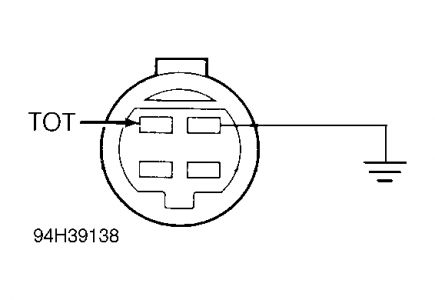Hard Failures
Hard failures cause Malfunction Indicator Light (MIL) to come on and trouble codes to be set in Powertrain Control Module (PCM) memory. Trouble code remains until problem is repaired. To retrieve trouble codes, see READING SELF-DIAGNOSTIC CODES . Use circuit tests to determine cause of malfunction.
If a sensor fails, PCM will use a substitute value in its calculations to continue engine operation. PCM can estimate failed sensor values based on feedback from working sensors. In this condition, known as Limited Operating Strategy (LOS), vehicle runs but driveability will not be optimum.
CIRCUIT TEST TOT - TRANSMISSION OIL TEMPERATURE SWITCH
NOTE:The PCM on all models is located behind center console, below radio. The TCM on Capri models is located behind glove box.
Check TOT Voltage Output Operate vehicle until transaxle fluid is at normal operating temperature. Turn ignition off. Install 4EAT Tester leaving TCM disconnected. Measure voltage between TOT test pin and ground. Allow transaxle fluid to cool. Voltage should increase from less than 1.5 volts to more than 10 volts as fluid temperature decreases below 302 °F (150 °C). If voltage is within specification, system is functioning properly. Connect all components and repeat QUICK TEST . If voltage is not within specification, go to next step.
Check TOT Switch Operate vehicle until transaxle fluid is at normal operating temperature. Turn ignition off. Disconnect TOT switch harness connector. Measure resistance between TOT terminals. See Fig. 14 . Allow transaxle fluid to cool. Resistance should increase from less than 5 ohms to more than 10 k/ohms as fluid temperature decreases below 302 °F (150 °C). If voltage is within specification, go to next step. If voltage is not within specification, replace TOT switch. Connect all components and repeat QUICK TEST .
Fig. 14: Identifying TOT Harness Connector Terminals

SPONSORED LINKS
Friday, February 27th, 2009 AT 5:53 AM






